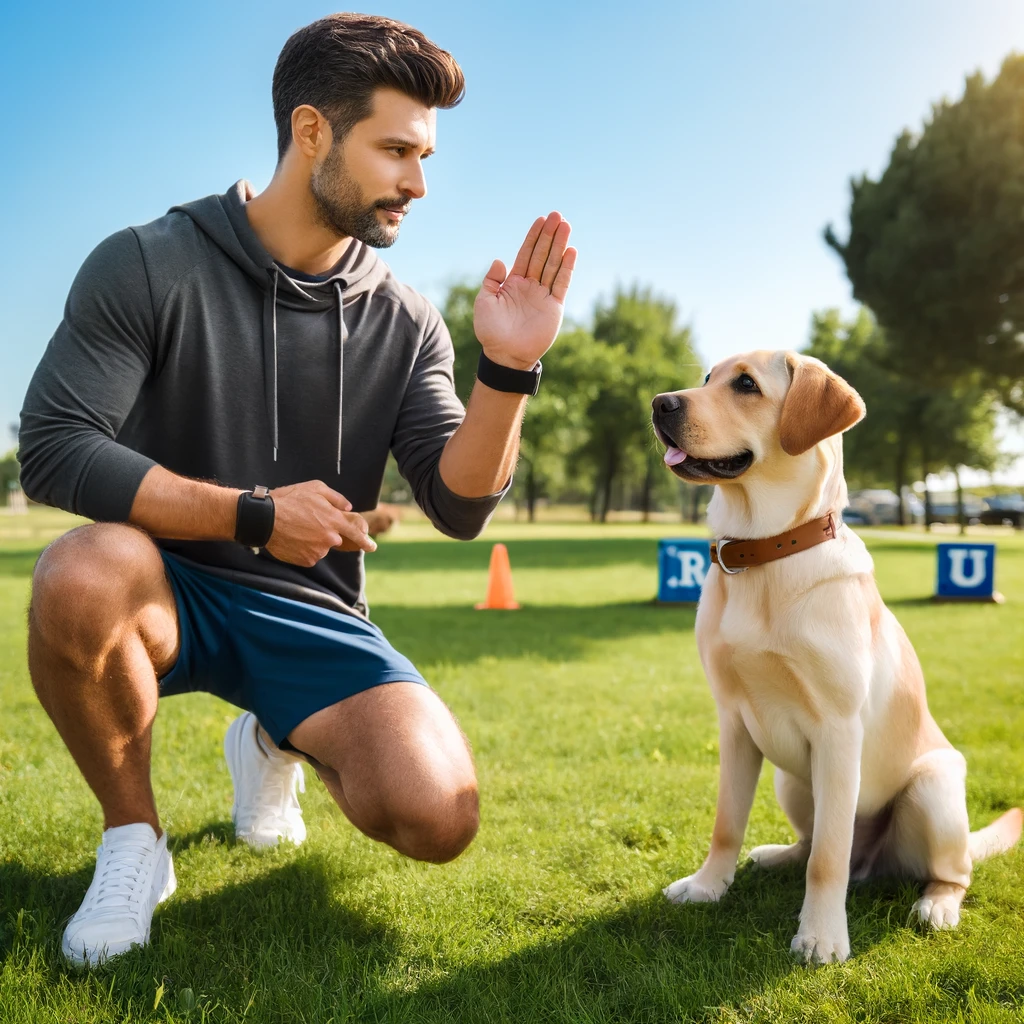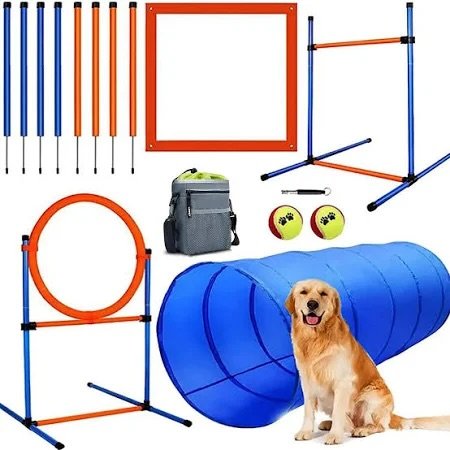Dog Agility Training & Classes in NYC
Fun, Engaging, and Rewarding Agility Courses for Dogs in New York City
Preparing for dog agility courses is a rewarding experience that strengthens your bond and enhances both mental and physical stimulation for your pet. However, preparation is key to ensure your dog is ready for the challenges of an agility course.
Here are several steps that can help get your dog ready for agility training in New York. But don’t worry, dogs of all ability levels can join agility class.
Get Your Dog Checked Out by a Veterinarian
Before embarking on agility training, it's a good idea to schedule a vet visit. Agility courses for dogs involve physically demanding work, so it's important to ensure that your dog is healthy and fit to handle the activity. The veterinarian will check for any underlying conditions, such as joint or heart issues, that could be exacerbated by running, jumping, or quick turns on the course.
Additionally, if you're planning to participate in group classes or agility events, your dog will likely be exposed to other dogs and various outdoor environments where feces and other contaminants might be present—especially in parks. Having your dog up to date on vaccinations like rabies, distemper, and Bordetella is essential to prevent the spread of disease. Regular parasite prevention for fleas, ticks, and heartworms is also a smart precaution. Ensuring your dog is in optimal health before starting training will help avoid injuries and illness.
Be Able to Train Your Dog to Perform Commands on Cue
In agility, the dog must follow commands immediately and with precision. Whether it's jumping over a hurdle, running through a tunnel, or navigating weave poles, you’ll need your dog to respond quickly to your verbal or physical cues. This requires your dog to associate specific words or hand signals with different actions.
For instance, using "up" for jumps, "tunnel" for entering tunnels, and "over" for hurdles can create clear communication between you and your dog. Your timing is critical—cue too early, and your dog might get confused; cue too late, and they might miss the obstacle or take a wrong turn. Practicing cues consistently will help your dog learn to anticipate and respond to your guidance, improving their agility performance.
Be Patient – Don't Rush the Process
Agility training is exciting, and it's tempting to jump right into the more challenging obstacles, like hurdles and tunnels. However, it's important to build a strong foundation first. Rushing the process can overwhelm your dog and cause confusion or anxiety, which can lead to poor performance on the course.
Start by focusing on basic commands and simple obstacles before moving on to more complex tasks. Training your dog’s muscles, joints, and mind to handle the demands of agility takes time. A slow, steady approach ensures your dog has the confidence and physical ability to handle more advanced maneuvers when the time comes.
Train Your Dog in General Obedience
Agility requires more than just athletic ability; it demands focus and discipline. Before starting any agility training, your dog should have a strong foundation in basic obedience. This includes commands like sit, down, stay, retrieve, and, most importantly, recall. Here’s why these commands are crucial:
Sit & Down: These commands help your dog maintain focus and self-control, both essential during agility competitions, where distractions abound.
Stay: In agility, you may need your dog to wait patiently before starting a sequence. A reliable "stay" ensures your dog doesn’t jump the gun.
Retrieve: While not a direct requirement, retrieval practice sharpens your dog's understanding of following commands and returning to you, reinforcing teamwork.
Recall: Dog agility courses are fast-paced, and a strong recall ensures that your dog listens to you and stays engaged, even when they're excited by obstacles.
Without a strong obedience foundation, your dog may become easily distracted or confused on the agility course, leading to frustration for both you and your pet.
Find Out What Motivates Your Dog for Agility Success
Every dog is unique—what excites one may not work for another. Finding the right motivation is key to successful dog agility training. High-value rewards—whether it’s a favorite treat, a beloved toy, or enthusiastic verbal praise—keep your dog engaged and eager to perform.
If your dog isn’t responding well to training, they may not find the reward motivating enough. For example, if your pup prefers a squeaky toy over basic kibble, using that as a reward will increase their drive and focus—which is essential in agility courses for dogs near me, where speed and precision matter.
Enhance Your Dog’s Training with Home Agility Equipment
While attending dog agility classes in NYC builds essential skills, home practice strengthens learning. You don’t need expensive equipment—even a simple agility set allows you to reinforce key skills like jumping, weaving, and balancing.
Practicing at home helps your dog master obstacles at their own pace, making class time more productive. If they struggle with certain agility challenges, home training provides a stress-free environment to refine their skills.
Strengthen Your Bond with Your Dog Through Agility
Agility is a team sport, and trust between you and your dog is essential. Beyond training, building a strong relationship through positive reinforcement and daily interactions creates a deeper connection.
One powerful technique is capturing behavior—marking and rewarding desirable actions when they naturally happen. If your dog steps onto a platform or balances on a log during a walk, reward them! This builds confidence and encourages them to take initiative on an agility course for dogs near me.
Join One of the Best Dog Agility Classes in NYC!
Looking for dog training classes in NYC that are fun, effective, and tailored to your dog’s needs? Whether you’re a beginner or experienced handler, our agility courses provide an exciting way to build confidence and skills.
Why Choose PJH Dog Training for Dog Agility in NYC?
✅ Expert Dog Trainers in NYC with years of agility experience
✅ Convenient Locations in Central Park, Riverside Park & Upper West Side
✅ Tailored Agility Courses for beginners & experienced dogs
✅ Small Class Sizes for personalized training
✅ Positive Reinforcement-Based Training for the best results
➡ Reserve your spot in one of the best NYC dog agility classes today!
Why Choose PJH Dog Training for Dog Agility in NYC?
✅ Expert Dog Trainers in NYC with years of agility experience
✅ Convenient Locations in Central Park, Riverside Park & Upper West Side
✅ Tailored Agility Courses for beginners & experienced dogs
✅ Small Class Sizes for personalized training
✅ Positive Reinforcement-Based Training for the best results
➡ Reserve your spot in one of the best NYC dog agility classes today!
PJH Dog Training - Dog Agility Training FAQs
1. What are agility classes, and how do they benefit my dog?
Our dog agility training in NYC helps dogs navigate obstacle courses, improving confidence, fitness, and mental sharpness. Agility also strengthens your bond with your dog, making training fun and rewarding.
2. Where are your agility classes located?
We offer agility classes in Central Park and Riverside Park during warm months and at our indoor dog training facility in NYC (W 93rd St. & Broadway). Find the best dog classes near me for your pup today!
3. What obstacles are included in your agility course?
Our course features weave poles, tunnels, teeter-totters, jumps, and more—all customized to your dog’s skill level for a safe and engaging experience.
4. How can I sign up for agility training for my dog?
You can register directly on our website! Choose your preferred time slot and enroll in one of the best dog agility classes in NYC. Sign up here.
5. Are beginners welcome?
Absolutely! Our beginner-friendly courses introduce dogs to agility equipment and techniques step by step, making it a stress-free experience.
6. What’s the cost and duration of your agility classes?
Pricing and class duration vary based on skill level. Visit our pricing page for more details and find the best fit for you and your dog.








